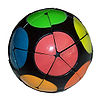
Impossiball
Encyclopedia



Icosahedron
In geometry, an icosahedron is a regular polyhedron with 20 identical equilateral triangular faces, 30 edges and 12 vertices. It is one of the five Platonic solids....
puzzle similar to the Rubik's Cube
Rubik's Cube
Rubik's Cube is a 3-D mechanical puzzle invented in 1974 by Hungarian sculptor and professor of architecture Ernő Rubik.Originally called the "Magic Cube", the puzzle was licensed by Rubik to be sold by Ideal Toy Corp. in 1980 and won the German Game of the Year special award for Best Puzzle that...
. It has a total of 20 movable pieces to rearrange, same as the Rubik's Cube, but all of the Impossiball's pieces are corners, like the Pocket Cube
Pocket Cube
The Pocket Cube is the 2×2×2 equivalent of a Rubik's Cube. The cube consists of 8 pieces, all corners.-Permutations:...
.
History
William O. Gustafson applied for a patent for the Impossiball design in 1981 and it was issued in 1984. Uwe MèffertUwe Mèffert
Uwe Mèffert has manufactured and sold mechanical puzzles in the style of Rubik's Cube since the original Cube craze. His first design was the Pyraminx and others include the Megaminx, Skewb and Skewb Diamond...
eventually bought the rights to some of the patents and continues to sell it in his puzzle shop under the Impossiball moniker.
Description
The Impossiball is made in the shape of an icosahedronIcosahedron
In geometry, an icosahedron is a regular polyhedron with 20 identical equilateral triangular faces, 30 edges and 12 vertices. It is one of the five Platonic solids....
that has been rounded out to a sphere, and has 20 pieces, all of them corners. The puzzle has twelve circles located at the vertices of the icosahedron, and opposite circles are the same color. Because of the rounded shape of the puzzle, the pieces move up and down as they are rotated. It is also possible to remove one piece, turning the puzzle into a spherical version of the 15 puzzle.
The purpose of the puzzle is to scramble the colors, and then restore it to its original state of having one color per circle. This puzzle is equivalent to solving just the corners of a Megaminx
Megaminx
The Megaminx is a dodecahedron-shaped puzzle similar to the Rubik's Cube. It has a total of 50 movable pieces to rearrange, compared to the 20 movable pieces of the Rubik's cube.- History :...
. The original Impossiball had the same colors as the Rubik's Cube: red, orange, yellow, green, blue and white. Meffert currently produces two versions, one with six colors and one with twelve. The six-color version (pictured) uses pink, two shades of orange, yellow, green and blue. All the pieces are still distinguishable, however, because the two pieces with the same three colors are mirror images of each other. The twelve-color version has red, pink, orange, yellow, two shades of green, three shades of blue, purple, brown and white.
Solutions
In spite of its daunting appearance and greater number of possible positions, the Impossiball is not much more difficult than the standard 2×2×2 Pocket CubePocket Cube
The Pocket Cube is the 2×2×2 equivalent of a Rubik's Cube. The cube consists of 8 pieces, all corners.-Permutations:...
. This is because it is not a deep-cut puzzle; it only has pentagonal face layers which are similar in structure to the square face layers of the cube. There are no pieces that do not have a counterpart on the cube. Many of the techniques employed in the solution of the Pocket Cube can also be adapted for the Impossiball.
Number of combinations
There are 20!/2 ways to arrange the pieces, since there is no way to create odd permutations without tampering with the puzzle. There are 319 ways to orient the pieces, since the orientation of the last depends on that of the preceding ones. Since the Impossiball has no fixed face centers, this result is divided by 60. There are 60 possible positions and orientations of the first corner, but all are equivalent because of the lack of face centers.
The entire number is 23 563 902 142 421 896 679 424 000 (roughly 23.6 septillion on the short scale
Long and short scales
The long and short scales are two of several different large-number naming systems used throughout the world for integer powers of ten. Many countries, including most in continental Europe, use the long scale whereas most English-speaking countries use the short scale...
or 23.6 quadrillion on the long scale).
See also
- Rubik's CubeRubik's CubeRubik's Cube is a 3-D mechanical puzzle invented in 1974 by Hungarian sculptor and professor of architecture Ernő Rubik.Originally called the "Magic Cube", the puzzle was licensed by Rubik to be sold by Ideal Toy Corp. in 1980 and won the German Game of the Year special award for Best Puzzle that...
- MegaminxMegaminxThe Megaminx is a dodecahedron-shaped puzzle similar to the Rubik's Cube. It has a total of 50 movable pieces to rearrange, compared to the 20 movable pieces of the Rubik's cube.- History :...
- DogicDogicThe Dogic is an icosahedron-shaped puzzle like the Rubik's cube. The 5 triangles meeting at its tips may be rotated, or 5 entire faces around the tip may be rotated. It has a total of 80 movable pieces to rearrange, compared to the 20 pieces in the Rubik's cube.- History :The Dogic was patented by...
- Alexander's StarAlexander's StarAlexander's Star is a puzzle similar to the Rubik's Cube, in the shape of a great dodecahedron.-History:Alexander's Star was invented by Adam Alexander, an American mathematician, in 1982...
- Combination puzzlesCombination puzzlesA combination puzzle, also known as a sequential move puzzle, is a puzzle which consists of a set of pieces which can be manipulated into different combinations by a group of operations. The puzzle is solved by achieving a particular combination starting from a random combination...
External links
- Meffert's puzzle shop
- Jaap's Impossiball page — contains solutions and other information

